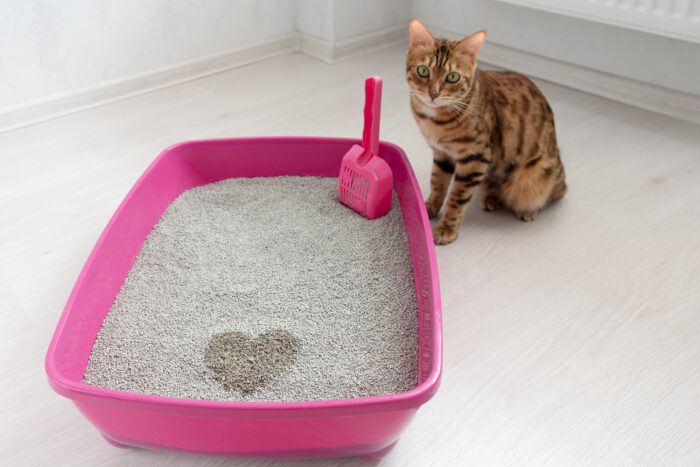The litterbox is, perhaps, the most important item that can make or break your relationship with your cat. If your kitty refuses to use theirs, it can be difficult to live in harmony, which is why elimination problems are the number one and most common complaint among cat parents and a leading reason why owners give up their cats to animal shelters.
End your cat’s elimination issues once and for all! Make your cat fall in love with their litter box with these expert tips and tricks.
1. Keep it clean!

Cats are often observed using their litterboxes immediately after they’ve been scooped, confirming that litter cleanliness plays a critical role in elimination behavior. Scoop the poop from the litterbox at least twice a day. Do a deep cleaning, including changing out all of the used litter for fresh litter, about once a week (depending on the type of cat litter you use). Clean the litterbox with hot water and fragrance-free natural soap. Avoid fragranced products and replace plastic litterboxes every year or two.
2. Have more than one litterbox

Even if you have only one cat, you should have two litterboxes around your home. The general rule is that you should have one litterbox for each cat in your home, plus one extra. So if you have three cats, you should place four litterboxes around your home, so your kitties always have an available box when they need it. One important point — don’t place the boxes next to each other, as this is akin to one large box for your cat. To give your cat the benefits of multiple boxes, you’ll need to place them in separate areas of your home.
3. Choose a peaceful location

Humans tend to place litterboxes in the laundry room or basement, but this can be problematic for cats. The loud noises from the washer and dryer could be startling to your cat. If your kitty is older, it may not want to go up and down stairs to reach a litterbox. Because distress in cats often leads to them eliminating outside of their litterbox, it’s important that their litterboxes are located in an area of your home that’s calm, secure, and frequented by your cat, like a catio.
4. Get A Large Litterbox

It’s important to experiment and figure out which type of litterbox your cat likes best, including different types of cat litter. If your cat jumps in the box and quickly gets out, eliminates while perched on the edge of the box, or will only put two paws in, there’s a good chance they don’t like something about the set-up. This is particularly true if they’re also eliminating next to, but not in, the box. It’s up to you to discover what your cat disapproves of. It could be related to the litter itself, like granule size, depth of litter or type. Or perhaps the litterbox is too small. Get a spacious litterbox. Your cat will love you for it!
5. Think like a cat

Think about your cat’s ancestors — ancient, desert-dwelling felines — when it comes to setting up their litterbox. In the desert, cats would eliminate outdoors where they could move freely and dig. Dr. Elisabeth Broussard, the Veterinary Surgeon at Citi Vet in Vredehoek, says that owners should “think like a cat” as they choose the best litterbox variety and location for their pets. This includes choosing unscented litter. “All that perfumy stuff is sometimes kind of annoying,” Dr. Broussard said.
First-time cat parents can discover your kitty’s litter and toiletry preference by buying the smallest amount available of several kinds of litter. Bio-degradable cat litter should be your first choice. Get some inexpensive litterboxes and place the boxes with different litters side by side. Monitor which box gets used most often. Once you know the type of litter your cat prefers, make sure it’s deep enough in the box, but not too deep – 10cm is recommended.
Conclusion
If your cat hops in the litterbox with no problem and rarely eliminates outside of it, you’ve succeeded in creating a litterbox environment that’s suitable for your kitty. If, however, your cat frequently eliminates outside of the box, it’s time to make some changes to the cleanliness, type, and location of your litterboxes, gradually, and see how your cat adjusts.
A trip to the veterinarian is also in order to rule out any underlying health issues — urinary tract infections, cystitis and Feline Lower Urinary Tract Disease (FLUTD), hyperthyroidism, kidney disease and diabetes are just some of the health problems that may underlie litterbox problems in cats.



